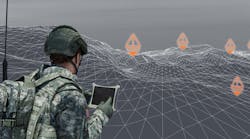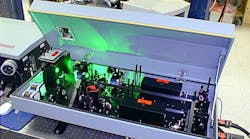By John Keller
CHELMSFORD, Mass.–Engineers at Mercury Computer Systems Inc. in Chelmsford, Mass., are offering a new sensor-fusion capability called the Converged Sensor Network (CSN) architecture designed to blend high-performance embedded computing systems into a converged sensor network environment.
The CSN architecture combines data fusion, exploitation, and dissemination with signal and image processing to enable intelligence, surveillance, and reconnaissance capabilities to forward-deployed areas of the battlefield, company officials say.
This sensor-fusion computing architecture also helps combine information from different types of sensors to provide intelligence products, such as overlaying an infrared image on a radar image to indicate the heat signatures of detected vehicles to indicate which of the vehicles might have been driven lately.
“The CSN is about putting sensor fusion exploitation inside the platform, such as UAVs [unmanned aerial vehicles], naval warships, and unmanned ground vehicles,” explains Ian Dunn, chief technologist for Mercury’s advanced computing solutions segment.
Mercury is using the CSN on a demonstration project involving high-data-rate modems and signals intelligence for detecting and countering improvised explosive devices (IEDs) for the U.S. Department of Defense (DOD) Joint Counter Radio Controlled Improvised Explosive Device Electronic Warfare program, otherwise known as J-CREW, Dunn says. Mercury experts now are working on moving the CSN architecture into multi-sensor applications for extension into the DOD’s Global Information Grid (GIG).
The CSN architecture seeks to enable military platforms to use reconfigurable computing while on station to change the way they process information and communicate that information to tactical networks during military operations. “CSN is about that glue–or making sensors a service on the network, not just providing data,” Dunn says.
Most of today’s sensor-fusion systems cannot enable a tactical network to reach back into the signal-acquisition and signal-processing chain to ask computers for different products, or even for the raw sensor data, Dunn explains.
The CSN is different, Dunn says. This architecture virtually gives network and remote-access to the functionality of signal-processing computers to give users access to all data and functionality of signal-processing computers–even to the algorithm level of the signal-processing chain, he says.
“We can trade off communications bandwidth to alter the number of sensor tracks and targets being tracked, to change or modify the application by giving network access to the systems applications,” Dunn explains.
“At a technical level, the CSN architecture supports the capture, processing, fusion, and storage of large streams of data from several sensors in real time. More importantly, it also enables a level of access to data, information, and computing resources deep inside a sensor, so that information analysts–and troops on the ground–can get the information they need before it’s too late,” says Mark Aslett, president and chief executive officer, Mercury Computer Systems.


